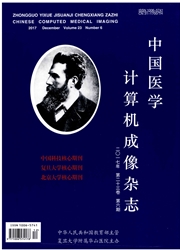

 中文摘要:
中文摘要:
目的:探讨径向K空间采样技术在胎儿心脏磁共振成像(MRI)中的应用价值。方法:选取33例2015年1~10月胎儿心脏超声心动图检查后怀疑先天性心脏病畸形的孕妇行胎儿心脏MRI检查。孕妇平均年龄(28.63±2.55)岁,孕龄平均(28.57±4.45)周。在其它扫描参数一致的前提下,采用径向采样和笛卡尔采样两种不同的K空间填充方式,测量升主动脉、心肌、羊水的图像信号强度值和噪声值,并计算主动脉的对比噪声比。由两位有10年以上心血管异常MRI诊断经验的医生对两组图像进行5分制双盲主观评分,评价整体图像质量、图像伪影和图像锐利度。结果:33例患者中,径向采样和笛卡尔采样的主动脉对比噪声比有统计学差异(P〈0.05),径向K空间填充相比于笛卡尔填充在整体图像质量、图像伪影和图像锐利度方面主观评价有统计学差异(P〈0.05),径向K空间采样在抑制条带状伪影中有明显优势。结论:径向K空间采样是一项MRI K空间填充技术,可有效抑制胎儿心脏MRI检查中的条带状伪影。胎儿MRI在诊断心外大血管畸形中有良好的空间分辨率和诊断优势,可以作为胎儿心脏超声检查的补充手段。
 英文摘要:
英文摘要:
Objective To discuss on the application value of radial K-space acquisition in fetal cardiac MRI. Methods After the echocardiography for fetal heart from January to October 2015, 33 pregnant women with suspected congenital heart disease were examined by fetal cardiac MRI. The average age and average gestational age of selected pregnant women were respectively (28.63±2.55) years and (28.57±4.45) weeks. With the other scan parameters consistent, the different K-space acquisitions of radial and Castesian were applied to measure the image signal intensity and noise value of ascending aorta, cardiac muscle, amniotic fluid, and to calculate the contrast to noise ratio (CNR) of aorta. Two radiologists, with over 10 years of experience in diagnosing cardiovascular anomalies with MRI, independently scored the images for the overall image quality, degree of motion artifacts, and image sharpness. Results Statistical differences were found in the CNR of aorta between radial and Castesian acquisitions for 33 selected patients (P〈0.05). And the subjective evaluation for overall image quality, degree of motion artifacts, and image sharpness of radial and Castesian acquisitions showed statistical differences (P〈0.05). Compared to Castesian acquisition, radial K-space acquisition showed obvious advantages in banding artifact suppression. Conclusion Radial K-space acquisition, a MRI K-space filling technology, effectively suppresses the banding artifact in fetal cardiac MRI examination. And the fetal MRI can be a supplement for echocardiography because the fetal MRI shows good spatial resolution and advantages in diagnosing vascular malformation.
 同期刊论文项目
同期刊论文项目
 同项目期刊论文
同项目期刊论文
 期刊信息
期刊信息
